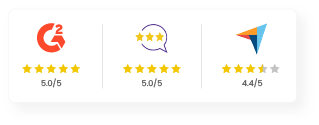A Complete Guide
Getting Management Buy-in for Learning Platforms to Enhance Employee Engagement
Getting Management Buy-in for Learning Platforms to Enhance Employee Engagement
When introducing any new technology investment, getting leadership buy-in can be challenging.
Building a business case for employee engagement with learning platforms to present to your CXOs involves demonstrating its clear benefits.
Here’s a step-by-step guide to build your case:
#Step 1: Define your Objectives and KPIs
For starters, clearly specify the objective of implementing learning platforms for employee engagement. This could include goals such as improving employee satisfaction and productivity, reducing turnover rates, or enhancing overall performance.
Then, identify key performance indicators (KPIs) that will measure the effectiveness of the learning platforms in achieving these goals. These could include metrics such as employee satisfaction scores, training completion rates, performance improvement metrics, retention rates, or even business outcomes such as revenue growth or cost savings directly attributed to enhanced employee engagement.
#Step 2: Select LMS/LXP Based on Objectives & KPIs
The next step should be to choose the appropriate learning technology solution, whether it is an LMS or an LXP. This decision should be anchored in its ability to contribute to the defined objectives and KPIs for employee engagement.
You need to select the right solution that directly supports the identified objectives and KPIs to ensure that your investment maximizes its impact on overall organizational success.
#Step 3: Focus on Platform Selection Criteria
Once the right solution type (LMS or LXP) has been identified, the next step is to identify the exact learning platform that best meets needs. When evaluating platforms, consider criteria such as scalability, user-friendliness, and analytics capabilities.
Scalability ensures that the platform can accommodate the organization’s current and future needs as it grows. User-friendliness is essential for seamless adoption and engagement among employees, while analytics capabilities enable tracking and measurement of key metrics.
#Step 4: Highlight Cost Considerations
While evaluating learning platforms, it is necessary to consider cost alongside the previously identified criteria. Assess the total cost of ownership (TCO), including initial setup, maintenance and potential scalability costs.
Ensure that the chosen platform offers value for money by aligning its features and capabilities with the organization’s objectives and KPIs for employee engagement. Additionally, consider factors such as licensing fees, customization costs and any additional expenses associated with integrations or support services.
#Step 5: Detail the Implementation Plan
Once you have covered basic groundwork, move to outlining a comprehensive implementation plan that covers all stages of deployment. This plan should include tasks, timelines, and responsible stakeholders for each phase – right from initial setup to full deployment and maintenance.
Break down the implementation process into manageable steps, such as system configuration, content migration, user training and testing. Allocate resources and establish clear communication channels to ensure smooth collaboration between IT teams, L&D and end-users throughout the process.
#Step 6: Set a Cadence for Sharing Results and Updates
Establish a regular cadence for sharing progress updates and results related to the implementation of the learning platform. This ensures transparency and accountability and keeps stakeholders informed about the impact of the platform on employee engagement.
Schedule regular meetings to review KPIs, milestones achieved and any challenges encountered during the implementation process. Provide updates on user adoption rates, training completion rates, and other relevant metrics to gauge the effectiveness of the platform in driving engagement.






